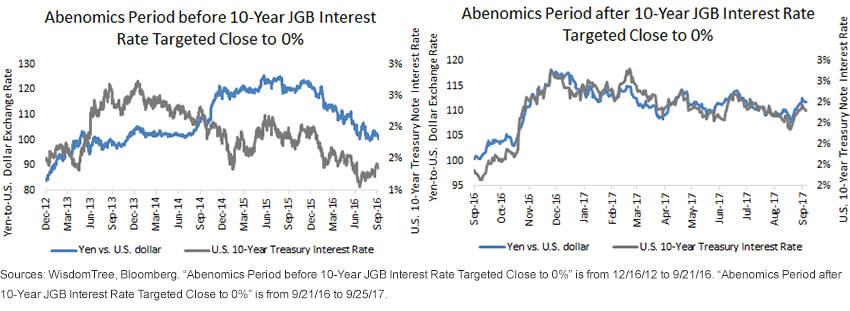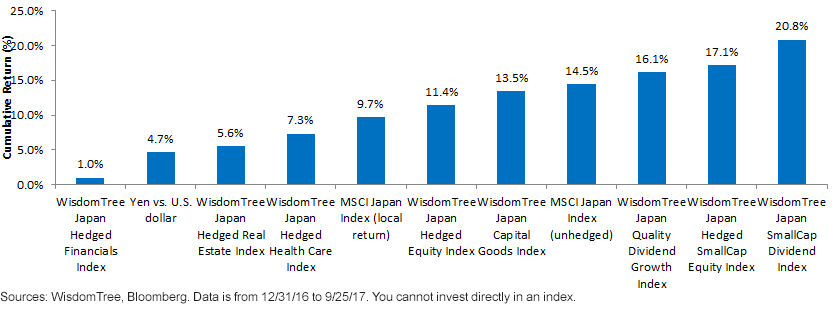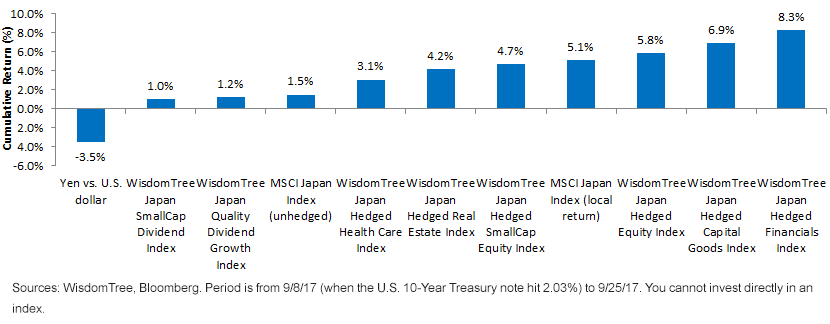What's Working in Japanese Equities?


In today’s global economy, the performance of many markets is influenced by a version of a single word: policy. Monetary policy. Fiscal policy. There is no getting around it—the consequences of both potential and enacted policy can cause massive shifts, and we’re seeing a lot of them in 2017, particularly in Japan.
Japan: U.S. Policy or Japanese Policy?
Talking about policy and how it relates to Japan would lead many observers to think of the term “Abenomics,” which began with the election of Prime Minister Shinzo Abe on December 16, 2012. It is remarkable to think that this term will see its five-year anniversary in only a few months. Notably:
- The yen was at approximately 83 to 84 to the U.S. dollar as of Abe’s election. The strongest point for the yen in 2012 was about 76.2. A weakening yen from these levels has been a central component of Abenomics.1
- In a September 21, 2016, policy announcement, Governor Haruhiko Kuroda of the Bank of Japan (BOJ) specified a policy to hold the interest rate of the 10-Year Japanese government bond (JGB) close to 0%. This means that the BOJ has committed to buying an unlimited supply of bonds to keep the price of the 10-Year JGB at that level.2
Consequence: The Yen Is Moving More in Line with the U.S. 10-Year Treasury Note Interest Rate than It Is with Abenomics Policies

- In the past, there was some positive correlation between moves in the U.S. 10-Year Treasury note interest rate and that of Japan’s 10-Year JGB. Today, the BOJ’s policy inhibits this relationship, forcing the transmission mechanism to transfer over to the yen, which is now moving in almost lockstep with movements in the U.S. 10-Year Treasury note interest rate.
- For those thinking about where the yen may go, there is now a connection that seems more tied to U.S. policy (such as corporate tax reform) than it is to anything being announced in Japan.
In a Constrained Yen Environment, What’s Working in Japanese Equities in 2017?
WisdomTree has one of the widest toolkits of Indexes focused on different strategies aimed at different swaths of Japan’s market. While by far the most familiarity surrounds the WisdomTree Japan Hedged Equity Index, the full picture can tell us important things about the dynamics of Japan’s market.
WisdomTree’s Japanese Equity Strategies Showcase Wide Divergence in 2017

For definitions of indexes in the chart, visit our glossary.
- The U.S. 10-Year Treasury note began 2017 at approximately 2.4%. On September 25, 2017, it was at about 2.2%, meaning that U.S. yields have actually declined at the 10-year point on the yield curve. A direct contributor to this move is the 4.7% appreciation of the yen versus the U.S. dollar. Of course, an appreciating yen is not the best condition for Japan’s exporters (focused upon in the WisdomTree Japan Hedged Equity Index), but it draws our attention to another part of Japan’s market—the small caps (shown in the WisdomTree Japan Hedged SmallCap Equity Index and the WisdomTree Japan SmallCap Dividend Index).3
- The two best-performing WisdomTree Japan equity strategies are focused on small caps—one is hedged and the other is unhedged. With the yen appreciation this year, it makes sense that the unhedged strategy took the top position. In many ways, these stocks (the same in each of these Indexes—the only difference is the currency exposure) are the opposite of Japan’s exporters, deriving approximately 80% of their weighted average revenue from within Japan.4 At a time when the forward P/E ratio of the Russell 2000 Index is above 30x, the fact that the WisdomTree Japan SmallCap Dividend Index is trading at a forward P/E ratio of less than 13.0x makes it additionally interesting.5
Japan’s Exporters Could Be a Coiled Spring
If people asked us what might surprise us in Japan in the final quarter of 2017, we would come back to the fact that Japan’s large-cap exporters are trading at a very low multiple (the WisdomTree Japan Hedged Equity Index had a forward P/E ratio of 13.1x versus 14.5x for the TOPIX as of September 25, 2017). Any catalyst that weakens the yen could cause a significant reaction. When the U.S. 10-Year Treasury note bounced upward off of a near-term low of almost 2.0%, we saw a microcosm of what this type of reaction could look like.
WisdomTree’s Japanese Equity Strategies during a Short-Term Bounce in U.S. Rates

- As the yen weakened, we saw it really play out in the WisdomTree Japan Hedged Capital Goods Index and the WisdomTree Japan Hedged Financials Index. It’s notable that Japanese financials have faced headwinds and could represent one of the best valuation opportunities in Japan’s market. The WisdomTree Japan Hedged Equity Index (exporters) was close behind.
Conclusion: A Complete Market Exposure Could Be the Best Approach
While we wish we knew which way the yen would go, it has been very tough to predict. An interesting strategy could combine something like Financials, Capital Goods or exporters with small caps in order to play both sides of where Japan’s equity market (and the yen) may go.
1Source: Bloomberg. Abe’s election refers to 12/17/12, as the market was not open on 12/16/12. The yen’s strongest point in 2012 was achieved on 2/1/12.
2Source: “New Framework for Strengthening Monetary Easing: Quantitative and Qualitative Monetary Easing with Yield Curve Control,” Bank of Japan, 9/21/16.
3Source: Bloomberg, with data referring to the period from 12/31/16 to 9/25/17.
4Source: FactSet, with data as of 8/31/17.
5Source for forward P/E ratios: Bloomberg, with data as of 9/25/17.
Important Risks Related to this Article
Investments focused in Japan increase the impact of events and developments associated with the region, which can adversely affect performance.

Christopher Gannatti began at WisdomTree as a Research Analyst in December 2010, working directly with Jeremy Schwartz, CFA®, Director of Research. In January of 2014, he was promoted to Associate Director of Research where he was responsible to lead different groups of analysts and strategists within the broader Research team at WisdomTree. In February of 2018, Christopher was promoted to Head of Research, Europe, where he was based out of WisdomTree’s London office and was responsible for the full WisdomTree research effort within the European market, as well as supporting the UCITs platform globally. In November 2021, Christopher was promoted to Global Head of Research, now responsible for numerous communications on investment strategy globally, particularly in the thematic equity space. Christopher came to WisdomTree from Lord Abbett, where he worked for four and a half years as a Regional Consultant. He received his MBA in Quantitative Finance, Accounting, and Economics from NYU’s Stern School of Business in 2010, and he received his bachelor’s degree from Colgate University in Economics in 2006. Christopher is a holder of the Chartered Financial Analyst Designation.

